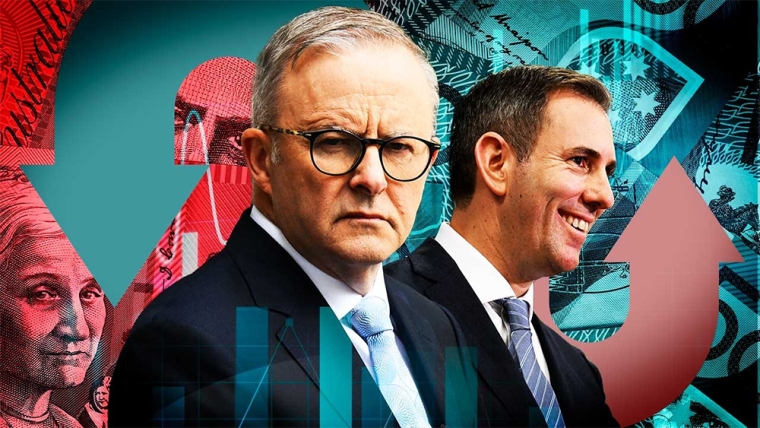
In his 1964 book The Lucky Country, Donald Horne wrote that “Australia is a lucky country run mainly by second rate people who share its luck”. After less than a year in power, it’s too early to tell whether the current federal government are ‘second rate people’, but there’s no doubt they’re lucky.
Just look at the budget delivered yesterday by Jim Chalmers, the Labor Treasurer.
In only seven months, the forecast for Australia’s accounts this year has flipped from a deficit of $37 billion to a surplus of $4 billion. Since last year’s budget, the cumulative forecast fiscal improvement over the next four years is over $100 bn.
If Chalmers delivers his projected surplus for the financial year to 30 June, he will be the first Treasurer to do so in 15 years. The first Labor Treasurer since Paul Keating way back in 1989.
Good luck or good management?
The Treasurer claims much of the credit for getting the budget ‘back in black’. However, that claim must be seen in the context of a government that’s been in office for less than 12 months.
There are three primary drivers behind the disappearing red ink in the current year. The most important is lower than projected unemployment which has led to higher income tax collections and lower welfare payments. According to the government, this accounts for 40% of the dramatic turnaround in the fiscal position.
Unsurprisingly, the second major contributor to that turnaround is higher than projected prices for some of Australia’s export commodities. The Treasurer can thank Vladimir Putin for much of that.
Finally, higher than expected corporate profits this year have lifted company tax revenue significantly.
All in all, it’s raining cash in Canberra. To use a popular Australian figure of speech, the Treasurer’s been hit in the backside by a revenue rainbow.
In the words of the Shadow Treasurer, Angus Taylor, a ‘drover’s dog’ could have delivered a surplus this year. Maybe, but it must still grate on the opposition that a Labor government will achieve something that the previous Coalition government was unable to do during three terms in office.
For many years, the Coalition has consistently branded the Labor Party a ‘bad economic manager’, the party of ‘debt and deficit’. Given the centrality of the economy to voters, this branding has often damaged the Labor Party’s electoral prospects. Delivering a surplus in his first budget (and ‘banking’, rather than spending, more than 80% of the revenue upgrades) will help Chalmers change the narrative.
But one surplus doesn’t make an economic summer. Yesterday’s budget figures revealed that that surplus will be followed by a series of deficits over the forward estimates. Those projected deficits are significantly lower than was forecast just seven months ago but they are still deficits.
Chalmers attributes the improvement going forward to a combination of ‘modest but meaningful’ tax increases, prudent spending restraint, and intelligent savings and adjustments.
The tax increases include a rise in tobacco excise, an increase in the Petroleum Resource Rent Tax for gas producers, and a minimum tax of 15% on multinationals. In other words, all the easy targets and nothing substantive that might cost the government votes.
The major spending increases include power bill rebates of up to $500 for 5.5 million households and up to $650 for one million small businesses, higher subsidies for GP visits for 11.6 million Australians, a lift in a range of social welfare payments, and additional spending on renewable energy.
There’s even $300 million to establish an AFL team in Tasmania.
The expenditure increases seem high, but they are relatively restrained in the context of a $2 trillion economy.
That restraint was needed for two reasons – to shore up the government’s claim to be a ‘responsible economic manager’ and to avoid putting upward pressure on inflation.
Australia is still struggling with high inflation and the government could not risk exacerbating the problem with an overly expansionary budget. To do so after the Reserve Bank of Australia has raised interest rates in 11 of the past 12 months to dampen the economy would have been irresponsible.
Jim Chalmers will get credit in some quarters for resisting the temptation to open the expenditure floodgates. He’s been under a lot of pressure to do so, both from his parliamentary colleagues and from many of the Labor Party faithful. After nine years in the electoral wilderness, the urge to splurge on social welfare programmes and improved public services is intense. So the pressure on the Treasurer will only increase.
Yesterday’s budget revealed a dramatic improvement in Australia’s fiscal position, including the slow unwinding of a structural deficit of around 2% of GDP over the next decade. However, that outcome is premised on continuing restraint in the face of a range of fiscal threats. These include escalating defence commitments, the rapidly rising cost of aged care and health services, and the interest bill on rising government debt that has increased sharply with higher interest rates.
Perhaps the biggest threat is Australia’s generous National Disability Insurance Scheme. Previously, this had been projected to rise at an astonishing 14% pa. By imposing a growth cap of 8%, the Treasurer has created a saving of $15 bn over the forward estimates and $60 bn over ten years. What is not explained is how that cap will be accomplished.
Overall, the budget assumes real annual spending growth of just 0.6% pa. That will be a challenge for a Labor Treasurer in the current environment.
What the government really needs is substantive tax reform or other measures to drive higher productivity. Failing that, yesterday’s optimistic budgetary projections may prove unattainable unless the Treasurer is prepared to implement either major tax increases, major spending cuts, or some combination of the two.
Or he gets another revenue windfall from booming commodity prices.
That can never be ruled out for the lucky country but it’s no way to run a national budget.
The Australian government should be preparing for the next negative shock, whether a financial crisis, a global pandemic, or a geopolitical emergency. The sad reality is that such preparations often require the courage to make politically unpopular decisions.
That’s the real test for Jim Chalmers and the Labor government.
*Ross Stitt is a freelance writer with a PhD in political science. He is a New Zealander based in Sydney. His articles are part of our 'Understanding Australia' series.
8 Comments
Australia is incurring a lot of liabilities as well due to rapid population growth requiring urgent new infrastructure and housing investment. At first glance you might think it looks it's all gravy but they have the same growth pains as New Zealand.
Aust net population growth of a person every 50 seconds, 600k per year. Sounds a bit high. 2 thirds is from immigration
The Aussie Budget just dropped the tax rates for middle to high income earners. The new tax rate will be 30% for those on incomes $45k to $200k (plus the first $18k is still tax free).
Plus 2% medicare levy?
If so not too different from NZ
Hugely different! For starters, the compulsory super contribution of 10.5% is not included as taxable income. And the first $18,200 of income is tax free. Which is great if you have a non-working spouse and they can get dividends, interest and rental income allocated to them.
Also in Australia you can salary package things to lower your taxable income. Cars, childcare fees, school fees, mortgage payments, health insurance, additional super contributions, utilities, even things like restaurant meals .... All of these things are paid with pre-tax income and lower your taxable income for the tax brackets. So if you were on $250k a year you simply salary package $50k of expenses a year, and you are no longer paying 45% tax on anything.
Most people just compare headline tax rates and assume the tax system is the same, but its not.
Thanks to higher top rates and a capital gains tax.
The foreign company tax , is that on total profit of the australian operation.??
Of course a government surplus means a private deficit.

We welcome your comments below. If you are not already registered, please register to comment.
Remember we welcome robust, respectful and insightful debate. We don't welcome abusive or defamatory comments and will de-register those repeatedly making such comments. Our current comment policy is here.